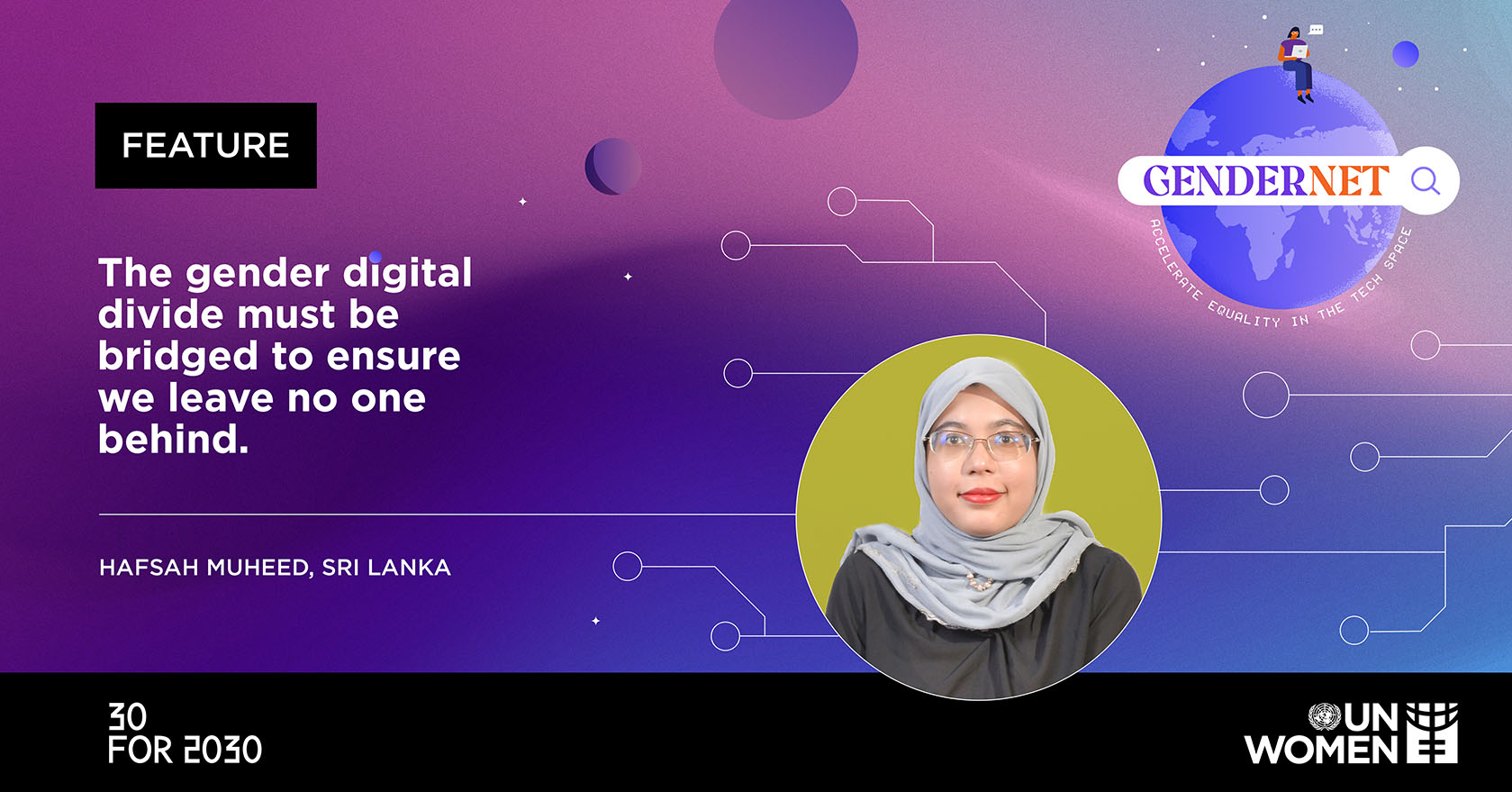This article is part of the GenderNet Campaign, supported by the Changemakers Project: Youth, Technology and Innovation to End Violence Against Women and Girls in Asia and the Pacific (2021-2023) with the generous fund from the Government of the Republic of Korea, through the Ministry of Gender Equality and Family.
The gender digital divide must be bridged to ensure we leave no one behind
Date:
Author: Hafsah Muheed, 30 for 2030 Network Member

As the world increasingly moves online, opportunities for business, education and entertainment are not booming equally for all. Women and girls risk facing a range of barriers to equal access to the internet, many of them extensions of longstanding discrimination and repression. And once online, they face a range of digitized harassment and abuse. This needs addressing to ensure they are not left behind and excluded from making the most of the technological tools of the future.
Chat GPT and the possibilities of AI are dominating conversation across sectors and geographies, while 37 per cent of the world’s population do not have access to the internet. With the rapid pace of integration of the digital world in our day-to-day lives from daily convenience, quality of life, accessibility and even solutions to global and local issues, technology is being used as a medium. The world has digital halves; the digital and the non-digital even before the pandemic. Women and girls are in the non-digital half. The digital divide impacts gender equality because it becomes harder for women when poverty, and geography is considered, and there is a large proportion of women and girls that do not have access to the internet. This results in absence of equality of opportunities for education and financial independence.
"The digital divide is also a source of inequitable access to information and communication.”
— Hafsah Muheed, 30 for 2030 Network Member
The pandemic exacerbated the inequalities further when opportunities that were present physically now operate largely in the digital space. Those who are on the advantaged side of this divide have access to a variety of technology that others do not, which can result in an inequality of opportunity and social mobility. The digital divide is also a source of inequitable access to information and communication. For example, those without internet at home may not be able to get emergency alerts or police reports when needed. In addition, there is often a lack of quality education available for children who do not have access to the internet at home. This can cause poor literacy skills, difficulty with math and other STEM fields of study, as well as an inability to use technology in everyday life. Without these skills, women are pushed out of the workforce and lose opportunities for higher-paying careers.
Asia and the Pacific (APAC) is identified to be the centre of digitalization and economic growth by the World Economic Forum. Projections are that APAC will make up more than 50 per cent of the global economy by 2050, with digitalization contributing roughly 60 per cent. By 2040, the estimated investment gap for APAC digital infrastructure is expected to reach USD512 billion (Cox, IJ Global 2022). How much of this is focused on bridging internet access to women and girls is unclear. A focus on driving Innovation is visible, yet if funding is not directed to the critical needs of digital infrastructure to the most vulnerable, we are actively taking part in leaving some people behind and creating new forms of marginalization.
Some countries require additional documents such as marriage certificates to obtain access to digital infrastructure.
Some ways the digital divide can be bridged are by increasing access to technology, improving education about the use and application of technology, as well as providing training on how to properly use and maintain various types of technology. Some countries have taken steps towards bridging this divide by developing laws on broadband internet access, establishing policies that help low-income families obtain broadband internet, creating plans to provide public access computers at libraries or other public locations, and more. Many governments around the world are working to reduce or eliminate the digital divide.
Ways to bridge the gender digital divide are as follows:
- Make the digital environment safe for women and girls. A great example is https://www.feministinternet.com
- Ensure girls' access to education such as the Kosovo Digital Economy Project, which trains rural women in programming and web design to become online freelancers, and shows how digital skills training can create pathways to economic prosperity.
- Establish a digital infrastructure that is practical and affordable and available for use. An example would be The Alliance for Affordable Internet (A4AI), which aims to reduce the cost of broadband internet in specific areas of the world. Starlink provides high-speed internet and global coverage at affordable prices via satellites it has launched into space.
- Provide accessible skilling and training programs for girls and women including women with disabilities, and illiterate women. An example would be when Huawei launched a Digital Training Bus specifically to benefit rural women in Bangladesh, which as of December 2019 provided training for over 63,000 women.
- Promote women-led infrastructure providers. This example came out as a finding from a community solution study conducted by the World Bank in 2021.
- Set up a Femtech-friendly support service ecosystem. Femtech start-ups have the challenge of finding scaling support. Some great examples are programmes such Tech4Eva Accelerator and retailers such as Love Bonito holding a minority stake in Moom, Maya & Mili as shared by the FemTech Association of Asia.
- Introduce national-level policies. An example would be traditionally underutilized universal service. Access funds can help but only four out of 69 countries have deployed such funds (Hammond & Srinivasan, World Bank, 2021). The ITU member states coalition supports ensuring efficient utilization of the funds via national level policy is critical in facilitating digital inclusion.